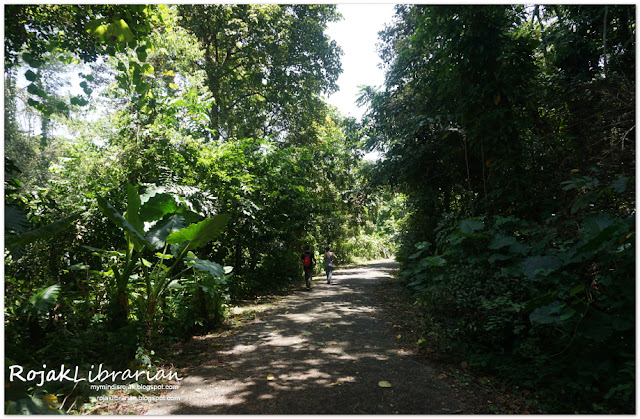It started off with a walk at Kopi Sua (at the Mount Pleasant side) and as we were exploring Onraet Road, we came across the tomb keepers who tend to the cemetery there. Our conversation led to them asking me whether i was aware that there was a mass grave for Japanese soldiers nearby Onraet Road? We knew that Mount Pleasant was the scene of an intense skirmish that took place on 14th February 1942 just before Singapore surrendered but I didn't really know much about the stories that took place in the area, especially post-surrender and beyond. The tomb keeper claimed that they have seen it in a forested area between the Onraet Road and the black and white white houses of Mount Pleasant and pointed to us the rough location. We searched the valley of forested area (see red circle in the picture below) for a while but left empty handed without any evidence of any man-made structure that existed that could be symbolic of this so-called mass graves for the fallen Japanese soldiers. Since then i have been wondering whether there was any truth to this story as unlikely the tomb keepers would pull a fast one when it came to stories like this.
 |
| Onraet Road walk |
Mass grave of 76 Japanese Soldiers & partially destroyed Memorial
In a 27 June 1948 newspaper article it was mentioned that the Graves Registration, FARELF (Far East Land Forces) resumed the search for the unknown graves from information obtained through P.O.W records and local sources. On the first day of operation, they found the body of a captain of the 9th Royal Northumberland Fusiliers in a private garden at Mount Pleasant. His boots, forage cap, tags and other marks of identification were discovered. Within the same compound, about 100 yards (91 meters) from where the grave of the captain was discovered, is a mass grave which contains the corpses of 76 Japanese soldiers. A concrete memorial that was partially destroyed by American soldiers after the liberation was erected beside the mass grave by the Japanese. The story goes that the Japanese soldiers were the war dead after a heavy fighting that happened in Mount Pleasant in an attempt to dislodge the entrenched British soldiers. The bodies of 76 Japanese soldiers were gathered from around the compound of the Mount Pleasant Houses and in areas nearby and buried in this mass grave. The Graves Registration Unit mentioned that the mass grave will not be disturbed. (Does it mean also that the remains of this Japanese soldiers were not exhumed and still remains in-situ till today? )
 |
| corpses of 76 Japanese soldiers |
The 1948 article finally proves that there was indeed a Japanese Memorial built and that memorial was for 76 Japanese soldiers that died in an intense battle to overwhelm the entrenched British and taking over their makeshift H.Q at Mount Pleasant. Who was this Captain that was clearly identified to be from the 9th Royal Northumberland Fusiliers, whose remains were exhumed and re-interred to Kranji ? With a bit of searching and luck, i found that it is likely to be a Captain Robert Watson of the 9th Royal Northumberland Fusiliers (RNF) whose burial form records by Padre Cordingly (Captain Eric Cordling, a padre with the 9th RNF) played a vital role in finding his body. Captain Watson was killed in action on 15th February 1942, the day of the British surrender and initially buried on the 16th February 1942 by Lt. Addy of the 9th Battalion in the garden of a house. That house was 159 Mount Pleasant Road.
 |
| Commonwealth War Graves Commission Record of Captain Robert Watson |
What happened here on 14th /15th February 1942
The book Tigers in the Park - The Wartime Heritage of Adam Road ( by Jon Cooper) gave valuable insight into what transpired here. In Chapter 17 of his book (The Defence of Mount Pleasant), it describes a heavy engagement to dislodge a Japanese machine gun unit that had pushed up into the vacant houses in the valley adjoining the houses held by the British. Attempts by the British to flank and flushed them out were met with heavy resistance and casualties. Eventually a 2-pounder anti-tank gun was used at the building housing the Japanese until eventually the remaining Japaneses soldiers retreated. "Hospital Hill" along Mount Pleasant Ridge was the other objective to be taken by the Japanese 41st Regiment. A Captain Taruko lead 11th Company on the attack across the valley and up the houses. He was supported by the heavy machine gun company under the command of 2 Lt. Yasuda. The Japanese were moving up into a "kill zone" zeroed in by British soldiers with Vickers machine gun on higher ground and having clear visibility of the advancing Japanese soldiers. Many were killed and maybe ended up at the mass grave for Japanese soldiers. From the book, you will also see a Sgt. Miyakubo of the 41st Regiment who took photos of the surroundings of some of the houses in Mount Pleasant just after the surrender of Singapore including house No. 166 Mount Pleasant which was damaged as result of the skirmishes.
References
Remains of 8 U.K. soldiers discovered. (1948, June 25). The Singapore Free Press, page 1
War Graves Team Makes more finds. (1948, June 27). Sunday Tribune
Tigers in the Park - The Wartime Heritage of Adam Road ( by Jon Cooper) , pages 185-188
Additional Resources
1) WW2 Archaeology dig at No. 159 Mount Pleasant
2) Video from Japanese perspective WW2

Maybe, they lay below one of the swimming pools.
ReplyDelete